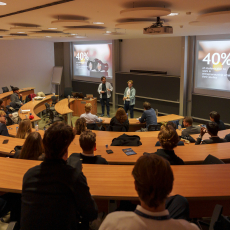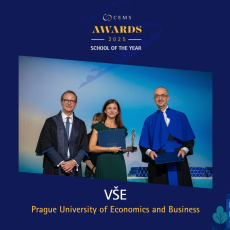Two-thirds of professionals (66%) surveyed* by CEMS – the Global Alliance in Management Education – fear that a hybrid working environment will limit their ability to learn from other colleagues.
In response, CEMS has published two sets of guidelines – one aimed at employees and one at employers - to ensure that valuable learning from colleagues continues, despite many companies not returning to the office full-time.
Gregory Whitwell, Chair of CEMS and Dean of the University of Sydney Business School, says:
“The hybrid working model is set to become the norm in many sectors, providing a long-sought after flexibility people have been craving for many years. However, the fact that 66% of the respondents feel that working between the office and home will limit their ability to learn from colleagues, is worrying, given that upskilling is so vital in a post-pandemic workplace.”
The guidelines have been compiled drawing on the wisdom of experts from among CEMS 34 global academic partners, 69 corporate partners and 8 NGOs.
Guidelines for employees:
- Seek to work for employers who can help you build your internal network - “At the recruitment stage, always ask prospective employers how they can help you build your internal network to learn from others within the organisation. Any organisation of reasonable size ought to have some good tools and platforms in place. If not, keep looking. It is a key ingredient for a successful future,” says Audrey Clegg, Global Head of Talent at Coca-Cola Hellenic Bottling Company.
- Create international ‘water-cooler’ moments – “The hybrid model requires employees to be more proactive in reaching out, connecting and networking outside of the immediate circle, as the arena for ad hoc meetings and ‘water cooler conversations’ are reduced,” says Heidi Robertson, Head of Diversity & Inclusion at ABB. “We must find alternative and innovative ways of connecting, and there is a huge opportunity in this. ‘Water cooler discussions’ can be extended to reach far wider than just your own location in the world, as virtual interaction allows us to connect across borders and timelines.”
- Reserve time for informal chatting as well as formal meetings – “Think of the informal time you would have with colleagues if you were in the same location and reserve that amount of time for informal chatting: have a virtual coffee break together, instead of leaving the computer, or have lunch together in separate locations” says Marie-Therese Claes, Professor at WU Vienna.
- Don’t be afraid to ask questions – “If you want to learn exactly how to do a certain task, ask a colleague to share their screen and allow you to watch them performing it!” says Vera Magin, Head of People Development at CEMS corporate partner Simon-Kucher Partners. “At Simon-Kucher new joiners not only meet (virtually or onsite) their close colleagues, but also a mentor and onboarding peers. We encourage every new joiner to maintain contact with these colleagues and proactively reach out for questions.”
- Learn from colleagues about both work and life. Usa Skulkerewathana, Senior Lecturer at National University of Singapore (NUS) Business School. “As work and life coexist at home, learning is beyond the work context. It also encompasses learning from other colleagues on how to integrate work and life in a professional manner. Such learning not only enriches knowledge but also enhances bonding among colleagues.”
Guidelines for employers:
- Make sure leaders lead by example - Usa Skulkerewathana added, “In addition to creating platforms for learning (online forums, focus group discussions, ground-up initiatives/projects), employees will be even more enthusiastic to learn when they see their leaders lead the way, set the tone and act as role models in work-life integration.”
- Put platforms in place to create upskilling opportunities – “Some institutions leave networking and upskilling to individuals, but the most productive help their people do it more effectively,” said Audrey Clegg. “Last year at Coca-Cola we launched our Opportunity Marketplace, which connects business demands, big and small, with people who can meet them and gain skills and visibility at the same time. Alongside international collaboration and maximising employee skillsets, a core component is a digital platform to post assignments. Employees complete a profile and are alerted when relevant opportunities arise.”
- Embrace mentoring and sponsorship. Gregory Whitwell, Chair of CEMS, says: “Professionals certainly benefit from being assigned a mentor who can provide guidance, advice, and encouragement. But they also need to have sponsors who are committed to opening doors, introducing them to other key players in the organization, expanding their network, and advocating on their behalf. Fundamentally, this is about ensuring that inclusivity is put into action rather than just talked about.”
- Make sure colleagues can still meet face-to-face – “Agree on a common set up for office hours, ensuring that colleagues do have the opportunity to meet and connect in person. Without a structure of and plan for common face time and without visible, inclusive leadership, the workforce may feel left outside or left behind,” adds Heidi Robertson.
- Allow informal meeting time. “As a professional it is hard to create informal time with colleagues if the company doesn’t enable that it in the first place, “says Marie-Therese Claes. “Make sure that as an employer you open up social time in the schedule. A lot of the most impactful learning and innovation arises from casual conversations between colleagues.”
Gregory Whitwell added,
“Authentic human connection is key to solving any crisis. Strategies must be put in place to make sure colleagues can maintain valuable human connection and learn from one another in a hybrid world. For companies and individuals who go that extra mile to get the very best out of people, the opportunities and benefits are huge.”
*510 global professionals
ENDS
For more information or interviews contact rebecca@griffithshuntpr.com +44 (0) 7792568421 or judith@griffithshuntpr.com, +44 (0) 7714 407060
About CEMS
CEMS is a global alliance of 34 academic members (leading business schools), 69 corporate partners (multinational companies) and 7 social partners (NGOs), dedicated to educating and preparing future generations of international business leaders, through the top ranked CEMS Master in International Management (MIM).The CEMS MIM is a one-year, pre-experience programme delivered by CEMS Academic and Corporate partners that offers students the opportunity to be educated in a truly multicultural and boundless classroom.




